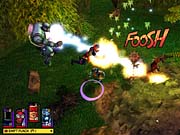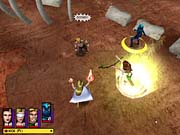Freedom Force Designer Diary #12
In his last designer diary for Freedom Force, Ken Levine talks about the game's intricate balancing process.
Entry #12 - 03/08/02
By Ken Levine
Executive Producer, Irrational Games
Three months ago I sent my brother a build of Freedom Force. Stu is an orthopedic surgeon now, but back when we were kids, he's the one who first turned me on to gaming. Albeit, in those days, gaming involved a cardstock map, cardboard chits, and a pair of dice--Avalon Hill style, baby.

Stu played through the build the best he could at that point. His response was, "Hey, it looks cool, but it's not much...uh...fun?"
He was totally right. Contrary to what most people think, games in development don't really get to be much fun until they are getting very close to the wire. I'd imagine there are a lot of games out there that didn't turn out too well, but if they had been allotted a couple more months of polishing and tuning, they might have turned out to be blockbusters.
This balancing and tuning period has always been a challenge for Irrational in particular because our games tend to be, for better or worse, genre breakers. What was System Shock 2? An RPG? A first-person shooter? An action adventure? Truth is, I have no idea. When you are less than absolutely certain what your target is, the balancing and tuning becomes all the more difficult.
What is balancing and tuning? OK, let me give you an example from our time on Shock 2. We knew we wanted the game to be "scary." Well, that's all well and good. But how do you make something scary? Turn down the lights, turn up the spooky music, and cross your fingers? Actually, a lot of what made Shock 2 scary was the balancing of the game. The player character was generally weak, and the monsters were fairly strong. The player was generally resource-challenged, and therefore had to watch every round of ammo and health kit. This encouraged cautious, slow movement through the world and careful aiming. Players couldn't wade into combat like a Quake-style tank. They had to take their time, look around corners, and even listen for the presence of bad guys. In this sense, games like Rogue Spear with their "one shot, one kill" mechanic play similarly. By making the player vulnerable, you encourage him or her to care.
Freedom Force presented a very different challenge for lead designer/project manager Jon Chey. Where Shock 2 had a set number of powers and bad guys, the open-ended nature of Freedom Force's super power system required a more holistic numerically based approach. With literally millions of possible super powers available, there would be no feasible way to test all the possible combinations (barring Jon himself acquiring the power of time travel). As the player (or designer, as we used the same tools to build powers as the gamer will in the game) builds a super power in Freedom Force, he or she can tweak it across a dozen or more axes. Want to make it more accurate? Go ahead, but it will make the character more expensive to acquire. Want to make your cool projectile spilt into three parts when it lands and heat-seek three different targets? That's cool, but be prepared to pay a price.

At the end of the day, it's going to be up to the gamers to decide whether the game is well balanced or not. And I'm certain the players are going to discover some exploits that eluded us. However, I don't think that's necessarily a bad thing. A core component of multiplayer games in particular is the "seesawing effect" of balance exploitation. One player learns a cool way to use powers in a game that no one thought of and that in many ways transforms the way the game is played--the most classic example of this is Quake's rocket jumping, a "feature" that the designers never foresaw (that is, a bug). The hallmark of a good game is that it's open-ended enough that gamers can find exploits to trump existing exploits. The more open-ended the design (that is, the more robust the simulation), the more this one-upmanship can be accommodated in multiplayer play.
One of the advantages of the architecture of Freedom Force's super power builder is that it's going to be nearly impossible to exhaust the exploit avenues. I learned this lesson while playing multiplayer last week. I thought I had this brilliant exploit where I used ManBot and El Diablo in combination to make what I thought was an unbeatable team. While El Diablo tossed out his devastating (yet expensive) long-range fire-based attacks, ManBot served as a life-sized Energizer bunny, constantly using his energy transfer power to keep El Diablo's energy meter topped off.
What I didn't count on was my foe using a custom character who was very, very fast and armed with a two super powers: the ability to siphon energy away from foes from point-blank range and very high fire resistance.
This little guy zooms in. El Diablo tries to whack him, but he shrugs off El Diablo's fire-based attacks with a snicker. El Diablo wastes all his energy trying to take out this pest, while simultaneously, the pest drains ManBot of all his energy, leaving ManBot and El Diablo helpless. Then my opponents' three badass characters (remember, he spent very little on the pest) move in for the kill...
We're all excited to see how the multiplayer community will take to Freedom Force. It's really quite unlike anything they've seen before. The Freedom Force community will be a key tool in helping us understand how to improve the game and make sequels that are even better than the original.
The game will be out in around two weeks, so this will be the final diary. Thanks for joining us through the development of Freedom Force. It's time for us to stop talking and start listening. Tell us what you think of the game and how we can make it better. We plan to be bringing super-powered men and women in spandex to you for a long time.
Got a news tip or want to contact us directly? Email news@gamespot.com
Join the conversation